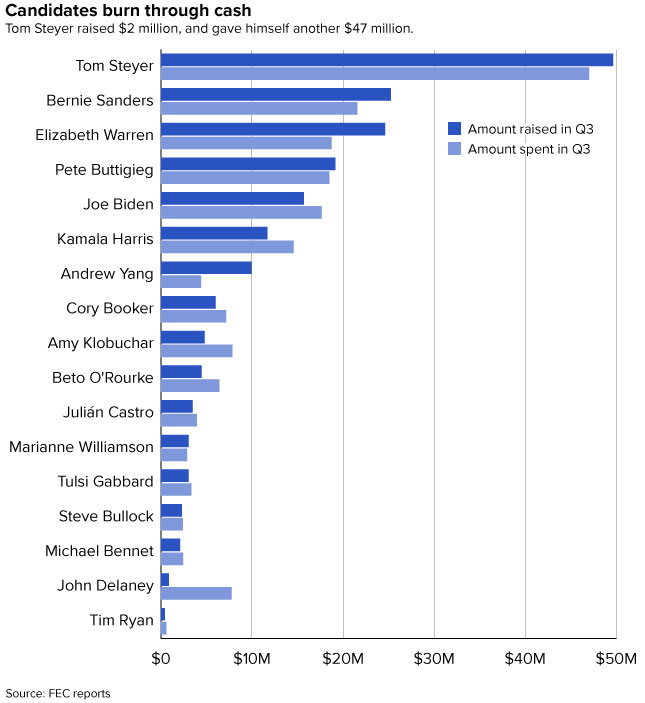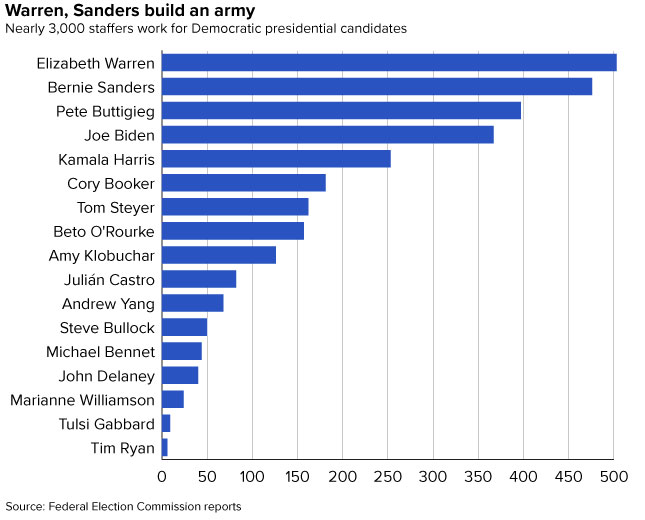Third-quarter fundraising sets Sanders, Warren, Buttigieg apart

Democratic presidential candidates raised a combined $186 million during the third quarter, setting a breakneck pace even as President Trump stockpiles a massive campaign account.
Three of the candidates who hope to face Trump next year — Sens. Bernie Sanders (I-Vt.) and Elizabeth Warren (D-Mass.) and South Bend, Ind., Mayor Pete Buttigieg (D) — have set themselves apart from the crowded field, both by raising more and keeping more money on hand than their rivals.
{mosads}Sanders has more than $33 million in the bank, according to his latest report to the Federal Election Commission (FEC), about $8 million more than Warren has on hand and $10 million more than Buttigieg.
All three candidates took in more money than they spent in the third quarter, adding to their stockpiles ahead of the four-month sprint to Iowa’s kickoff caucuses.
Other potential front-runners have begun to spend at a faster pace than they are able to replenish. Former Vice President Joe Biden’s campaign took in $15.7 million in the third quarter, his first full quarter as a candidate, but spent $17.6 million. He ended the quarter with just under $9 million in the bank — less than fourth-place finisher Sen. Kamala Harris (D-Calif.).
Harris, who has struggled to maintain momentum after a strong performance in the first Democratic debate in late June, raised $11.7 million and spent about $14.6 million from July through September.
“The candidates are heading into a period when they’ll probably have to do some heavy spending. It would normally be a good strategy to bank money now for this heavy push that’s coming ahead. To be drawing down now is not a great sign,” said Michael Malbin, a political scientist at the University of Albany who heads the nonpartisan Campaign Finance Institute.

Tech entrepreneur Andrew Yang was more thrifty with his money than any other contender in the field. Yang, whose email list swelled after he pledged in the September debate to give several families a $1,000 monthly stipend as an example of his plan to establish a universal basic income, raised $9.9 million in the third quarter and spent only $4.4 million. That burn rate, of just 44 percent, was lower than any other White House hopeful.
Former hedge fund manager Tom Steyer, on the other hand, has made the most of his billion-dollar fortune. Steyer spent years building an email list that allowed him to quickly qualify for the October debate, but his FEC report shows he raised only about $2 million since joining the race. He has given his campaign about $47 million and spent nearly all of it on television and digital media to introduce himself to voters.
Steyer’s self-funding makes him the least reliant on small-dollar donors to power his campaign. Biden, too, relies more on larger checks than other candidates: 68 percent of his contributions came from those who gave more than $200, the legal limit over which a campaign must report a donor’s name, address and occupation. Sen. Cory Booker (D-N.J.) and Harris each relied on big donors for more than 60 percent of their money.
Former Housing and Urban Development Secretary Julián Castro was the most reliant on small-dollar donors to fuel his campaign. Nearly three-quarters of the $3.5 million Castro raised came from those who have given less than $200. Almost 70 percent of the money Rep. Tulsi Gabbard (D-Hawaii) received last quarter came from small donors, and Yang got about two-thirds of his money from that group.
Both Warren and Sanders received about 60 percent of their money from the smallest donors. Buttigieg got a little less than half his money from small donors.
“As they are entering into the crucial phase, those three candidates have donors to whom they can return. To the extent that you’ve depended on donors who have maxed out, they’re done,” Malbin said. “That is a problem that Biden will have to address.”
Many of the candidates in the field are using their millions to build field armies to march across Iowa and New Hampshire in search of votes.

Warren, whose campaign is ubiquitous across the early states, had a staff of 503 in the last pay period before the quarter ended. Those staffers are spread among 47 offices throughout Iowa, New Hampshire, South Carolina and Nevada, as well as the campaign’s headquarters in Boston.
Sanders paid 476 staffers in the last pay period, while Buttigieg had 397 aides on payroll. Biden has staffed up quickly, too, with 367 operatives working for his campaign. Harris, who is rededicating her campaign to Iowa, is paying 253 people.
Collectively, the Democrats running for president employed nearly 3,000 people by the end of September.
By contrast, Trump’s campaign reported paying just 70 staffers at the end of September — though hundreds more work for the Republican National Committee, which operates hand in glove with the campaign.
Some of the lesser-known candidates are operating virtual shoe-string campaigns. Gabbard, who has not yet qualified for the Democratic debate in November, reported paying just nine staff members. Rep. Tim Ryan (D-Ohio), who has just more than $150,000 in the bank, had only two staffers on payroll, and another four serving as consultants.
Though the race is still in its early days, some campaigns are beginning to survey the Democratic electorate. Buttigieg spent $378,000 on the polling services of Joel Benenson, a veteran party pollster who worked in top jobs for former President Obama and for former Secretary of State Hillary Clinton’s 2016 presidential campaign.
Biden’s campaign paid its pollster, John Anzalone, $122,000 for field research, the FEC reports showed. Harris shelled out $120,000 to David Binder, another longtime Democratic pollster.
Neither Sanders nor Warren reported spending any money on polls. Trump’s campaign paid two pollsters — Tony Fabrizio and McLaughlin Associates — a combined $239,000 to test the electorate last quarter.
Candidates and their campaigns spend much of their money on air travel, zipping between early states and fundraisers in the country’s largest cities. But some candidates — particularly Biden — have developed a pricey habit of flying on private jets. Biden’s campaign reported spending $923,000 on chartered jets, twice as much as the next-highest spender, Buttigieg.
Biden’s campaign did not immediately respond to a request for comment.
Sanders’s campaign spent $360,000 on private flights in the third quarter. Harris spent $253,000 on those flights, and Warren’s campaign spent $132,000.
{mossecondads}Though the Democratic candidates spend their days bashing the influence of technology and social media giants like Facebook, Twitter and Google, those companies are among the biggest recipients of campaign spending. The FEC reports showed Biden, Buttigieg, Castro, Sanders, Steyer and Warren all spent seven figures on digital advertising buys — and those figures are likely much higher if the campaigns paid consulting firms to make buys on their behalf.
Steyer spent almost a third of his money, $14.8 million, on digital advertising buys. Buttigieg spent nearly $8 million online, including on some alternative platforms like Hulu, Roku and Pandora. And Sanders, who supports breaking up Facebook, spent $3.8 million on digital platforms.
The huge fundraising numbers show excitement among donors — both to the Democrats, who raised so much collectively, and to Trump, who maintains $83 million in his campaign account. Trump raised more money in the last quarter than any previous presidential candidate.
Malbin said many Democratic donors would come back to invest more, even if their chosen candidate does not win the primary.
“I’m willing to bet that every one of those donors, or a very high percentage of those donors who gave to any one of those candidates will continue to give to whoever’s the presumptive nominee,” he said. “There will be no lack of money on either side.”
Copyright 2023 Nexstar Media Inc. All rights reserved. This material may not be published, broadcast, rewritten, or redistributed. Regular the hill posts







